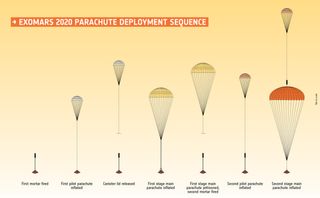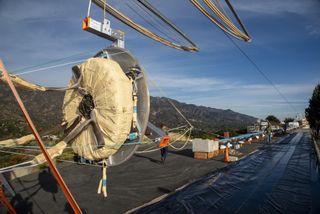Parachute problems could delay Europe's ExoMars rover launch to 2022: Report
Preparations to launch the ExoMars rover to the Red Planet this summer are in a crunch as critical parachute tests have again been delayed.
According to a media report from SpaceNews, the ExoMars mission "could be condemned to delay" even before the crucial parachute tests are performed in late March. The heads of the European Space Agency (ESA) and the Russian space agency, Roscosmos, the two main partners on the mission, are supposed to meet on March 12 to discuss mission progress.
The ExoMars rover's two big parachutes failed multiple high-altitude drop tests in 2019, when they sustained significant damage as they ripped through the atmosphere while simulating the rover's descent to the Martian surface.
Related: Europe's ExoMars missions to Mars in pictures

ExoMars 2020, scheduled to launch to the Red Planet in July, is the second part of the joint ESA-Roscosmos ExoMars program, which started out with the launch of the Trace Gas Orbiter and Schiaparelli lander in 2016.
A delay would mean that the rover, named Rosalind Franklin, may have to wait another 2.5 years for launch — until late 2022 — to make the journey to the Red Planet. Missions to Mars happen only when Earth is close enough to send a spacecraft there without using undue fuel to complete the journey. Such alignments happen only every 26 months, with launch windows lasting only a few weeks.
Looming over the discussions is what happened the last time ESA and Rocosmos tried to land something on Mars. On Oct. 19, 2016, the Schiaparelli lander crashed into the surface due to a data glitch that caused the craft's parachute to deploy prematurely.
Get the Space.com Newsletter
Breaking space news, the latest updates on rocket launches, skywatching events and more!
Schiaparelli was supposed to be an entry, descent and landing test probe for the ExoMars program, since both participating agencies lack direct experience landing on the Red Planet. Now, they will have to try again with their main payload, Rosalind Franklin. And in recent months, the pressure mounted even more when parachute problems emerged during testing for the mission, which is supposed to hunt for organics and signs of habitability on Mars.

High-altitude drop tests of a 50-foot (15 meters) supersonic parachute and a 114-foot (35 m) subsonic parachute both failed, in May and August last year, SpaceNews noted. Since the parachute tests must be passed before Rosalind Franklin launches, these problems could result in a delay.
ESA asked inspectors at NASA's Jet Propulsion Laboratory (JPL), a group that successfully landed four rovers on Mars so far, for help in pinpointing the cause. JPL found that parachute damage happened when the chutes were extracted from their bags, SpaceNews added.
ESA told SpaceNews that the next high-altitude drop tests of these parachutes will take place at the end of March, just three months before the launch window opens, on July 25. These tests had previously been scheduled for December 2019 and February 2020 but were recently pushed back — despite the fact that the six most recent ground tests, conducted late last year, showed that the parachutes have been extracting safely, ESA officials said in a statement.

Another factor in all these issues, the agency said, is the Roscosmos lander, named Kazachok. Derived from the Schiaparelli lander, Kazachok is a landing platform that will deliver Rosalind Franklin to the Martian surface. The ExoMars parachutes must be large and complex to bring the heavy lander down safely, as the lander does not have downward-facing thrusters to slow it down as it descends onto the surface of the Red Planet.
Another, smaller issue could cause delays if it is not addressed as planned. Engineers found "minor de-bonding in part of the solar array" on Rosalind Franklin during tests subjecting the rover to simulated Martian environmental conditions, an ESA spokesperson told SpaceNews. The agency, however, plans to make a mechanical fix, and the spokesperson added, "It is not seen as a serious problem."
Even if ESA's ExoMars mission doesn't make the journey in 2020, other agencies are lining up to go to Mars this summer. NASA's Mars 2020 rover and missions from Japan and China are all expected to lift off between July and August.
- 4 Mars missions are launching to the Red Planet in July
- How Europe's ExoMars missions to Mars work (infographic)
- Parachutes, sky cranes and more: 5 ways to land on Mars
Follow Elizabeth Howell on Twitter @howellspace. Follow us on Twitter @Spacedotcom and on Facebook.
OFFER: Save at least 56% with our latest magazine deal!
All About Space magazine takes you on an awe-inspiring journey through our solar system and beyond, from the amazing technology and spacecraft that enables humanity to venture into orbit, to the complexities of space science.
Join our Space Forums to keep talking space on the latest missions, night sky and more! And if you have a news tip, correction or comment, let us know at: community@space.com.

Elizabeth Howell (she/her), Ph.D., is a staff writer in the spaceflight channel since 2022 covering diversity, education and gaming as well. She was contributing writer for Space.com for 10 years before joining full-time. Elizabeth's reporting includes multiple exclusives with the White House and Office of the Vice-President of the United States, an exclusive conversation with aspiring space tourist (and NSYNC bassist) Lance Bass, speaking several times with the International Space Station, witnessing five human spaceflight launches on two continents, flying parabolic, working inside a spacesuit, and participating in a simulated Mars mission. Her latest book, "Why Am I Taller?", is co-written with astronaut Dave Williams. Elizabeth holds a Ph.D. and M.Sc. in Space Studies from the University of North Dakota, a Bachelor of Journalism from Canada's Carleton University and a Bachelor of History from Canada's Athabasca University. Elizabeth is also a post-secondary instructor in communications and science at several institutions since 2015; her experience includes developing and teaching an astronomy course at Canada's Algonquin College (with Indigenous content as well) to more than 1,000 students since 2020. Elizabeth first got interested in space after watching the movie Apollo 13 in 1996, and still wants to be an astronaut someday. Mastodon: https://qoto.org/@howellspace

